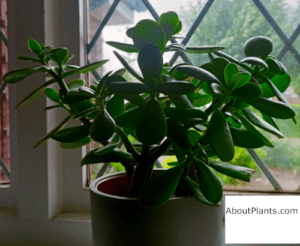The Money Plant is also known as the Jade Plant. The botanical name for a Jade Plant is the Crassula ovata. The Money Tree, or Jade Plant, is a succulent. The Money Plant is a shrub-like succulent that has stems, which as a very young plant are green but as it develops they become more brown and typically wood or trunk-like.
The money plant is native to South Africa. As a small, unestablished plant, money plants could be mistaken for other succulents due to their large thick leaves. The Money Plant is a very popular house plant in the USA and United Kingdom.
The Money Plant is a useful species for helping to purify the air indoors and it also helps capture some dust from the room due to the number and thickness of its leaves.
Money plants can bear flowers, although quite often they are not seen on an annual basis. When the Money Plant flowers, the flower tends to be a small star-shaped multi-petal flower, usually in light pink color or just off-white. The money plant usually flowers in winter if it flowers at all.
Maintenance of a Money Plant
Money plants do not require much maintenance. They may only require watering once a week. We tend to recommend very gently running water over the money plants whilst it is held over a sink so that all the leaves are covered in water and the soil is moistened but allowed to drain before it is put back into its decorative planter.
The money plant does not like to be sat in stagnant water. The leaves because they often collect a lot of dust from the room, prefer being rinsed off so that they can perform photosynthesis and repurification of the air in the room.

In winter they may not need to be watered very regularly at all, but always make sure that the soil does not dry out and if the leaves look to be shrinking, or withering/pitting on the surface, this is a sign that the plant needs watering more frequently.
In extreme summertime you may need to water the money plants more than once a week; perhaps two or three times a week, but again do not overwater the money plant because it is a succulent and it does not need to be watered every day, except on very very extreme temperatures or extreme atmospheric dryness.
Height and Spread
Money plants tend to grow to a height of 10 inches to 1.5 feet (20cm to 45cm) usually, but certain varieties can frequently grow up to 80 cm or even up to one meter in height. These spread between 1 foot and 3 feet (30cm to 80cm). Some very large money plants could actually reach up to 6 feet (2m) in height. However, this would require very specific environments indoors.
How Long Does a Money Plant Live?
The money plant can last for several years. We have had many plants growing for over 20 years that are well-established and very healthy. Usually, a Money Plant will need repotting every five years or more frequently if the soil or compost becomes contaminated or of a poor quality before that time.
As explained, the Money Plant does not need much maintenance, but it is still useful to feed money plants with a general-purpose fertilizer for succulents or indoor plants maybe once every year or so.
Potting a Money Plant
As explained, money plants require a nutritious compost that is kept moist. Some composts are specific for succulents. A general-purpose compost for indoor plants will suffice in most situations.
When potting the plant, put it into enough compost and use a plant pot which is a suitable size. We recommend potentially a 6 inch diameter and a height of approximately 8 inches for the main plastic plant pot with drainage holes, and this can be placed inside a suitable ornamental plants container or decorative planter to boost the aesthetic appearance of the Jade Plant in your room. Once you have potted a small money plant, ensure that the compost is watered thoroughly allowing it to drain before putting it in its non-draining, decorative planter.
Why is it Called a Money Plant?
The Jade Plant is a popular succulent revered for its aesthetics and cultural significance. Commonly known as the Money Plant, it is believed in many cultures to bring wealth and prosperity. However, the true richness of this plant lies in its biological characteristics and its fascinating natural history.
Types of Jade Plants
The Jade Plant, despite its broad common nomenclature, has various types, each distinct in appearance and growth:
- Crassula ovata ‘Minima’ – Often called the “Mini Jade”, it is a smaller version, perfect for compact spaces.
- Crassula ovata ‘Gollum’ – With its unique tubular leaves, it often resembles green fingers or the fictional character’s ears for which it’s named.
- Crassula ovata ‘Hobbit’ – Similar to ‘Gollum’, but with curled leaves forming a tubular shape.
- Crassula ovata ‘Variegata’ – It boasts green and yellow leaves, offering a variegated appearance.
Natural Habitat
Jade Plants are indigenous to the Eastern Cape of South Africa. Thriving in the rocky terrains and well-drained soils of this region, they have adapted to an environment that experiences occasional droughts. Their succulent nature is a direct evolution for water retention, enabling them to survive longer periods without rain.
Similar Plants and Shrubs to the Money Tree
Jade Plants are a part of the vast and varied world of succulents, many of which have overlapping features:
- Aloe Vera – Known for its medicinal value, this succulent is characterized by long, fleshy leaves.
- Echeveria – With rosette-shaped foliage, they come in varied colors, including blues, purples, and greens.
- Sedum morganianum – Commonly known as “Burro’s Tail” for its long trailing stems filled with small, plump leaves.
- Agave – Often mistaken for Aloe, it has sharper edges and is widely used in landscaping.
Characteristics of the Money Plant’s Leaf
The leaves of the Money Plant are a marvel in themselves. Thick, ovate, and glossy, they are a bright green color, often with red edges when exposed to direct sunlight. These succulent leaves are storage organs, brimming with water to support the plant during droughts. This adaptation makes the Jade Plant an ideal indoor companion, as it requires minimal watering.

Furthermore, like many plants, the Jade Plant plays a pivotal role in purifying the air. It can remove toxins, including volatile organic compounds from the environment. However, it is worth noting that while the Money Plant contributes to air purification, its efficiency may be relatively low compared to other indoor plants like the spider plant or peace lily.
In addition to its air-cleansing ability, the waxy surface of the Jade Plant’s leaves can collect dust from the room. Over time, a layer of dust can accumulate on the leaf’s surface, which not only hampers its appearance but can also inhibit photosynthesis. Therefore, regular gentle watering over a sink (as explained above), wiping with a clean moist cloth, or misting the leaves is recommended for both the plant’s health and aesthetic appearance.
To Sum Up Money Trees
The Jade Plant, or Money Plant, is more than just a symbol of wealth; it’s a testament to the wonder of botanical adaptations and the vast diversity of the succulent family. Its resilience, combined with its aesthetic appeal, makes it a favorite among plant enthusiasts and casual growers alike. As our understanding of plants and their roles in our environment continues to grow, the Jade Plant stands as a symbol of the intricate link between cultural association with prosperity, nature’s beauty and its functionality.
Precautions
We at about plants how several Money Trees and we think that they are an excellent addition to your home. Money Plants tend to be acceptable for most pets and are not known to be dangerously toxic. Always check with an expert before introducing any plants into your home if you are concerned about any other plants, people with allergies, or animals (or any other potential issue).
Thank you for reading this article about Money Plants at AboutPlants.com. We hope you have found this information to be useful.